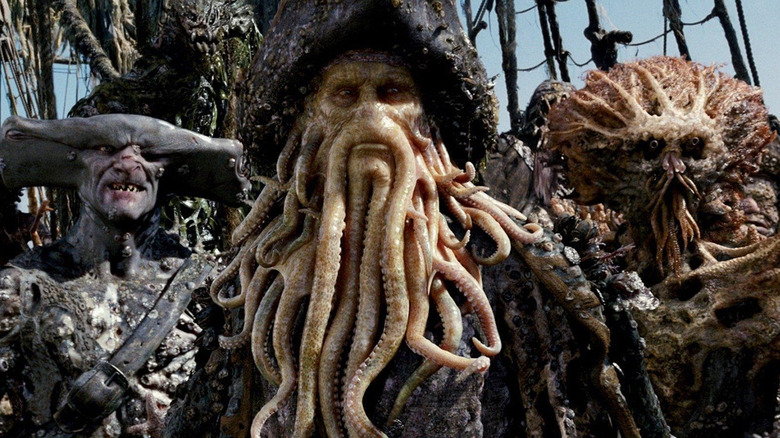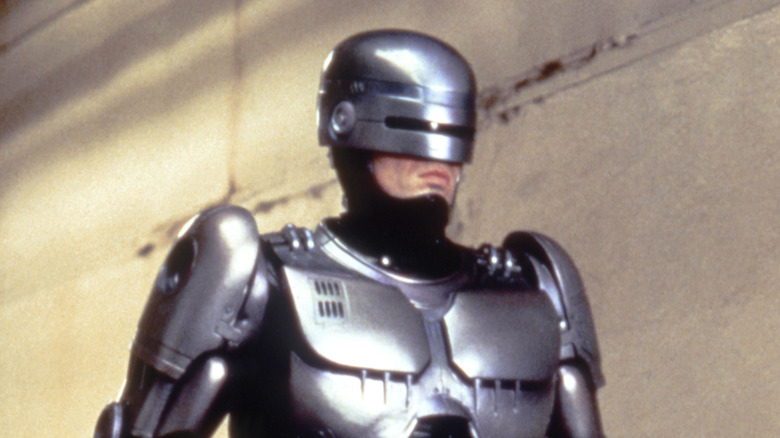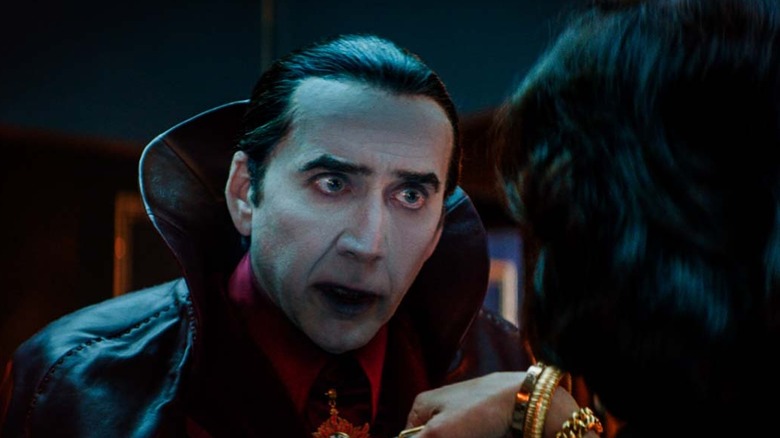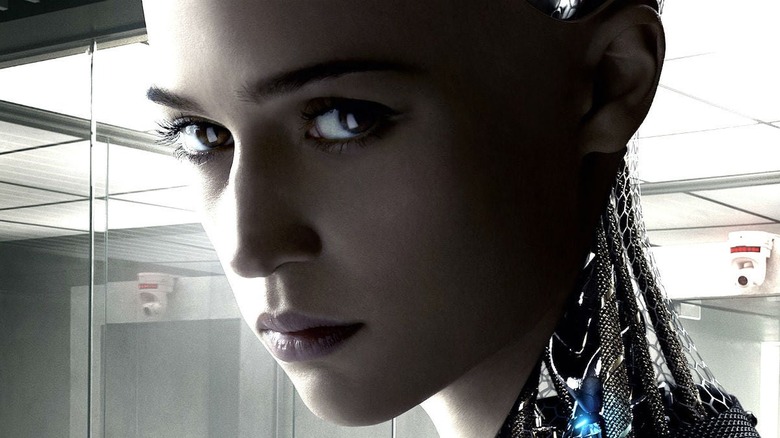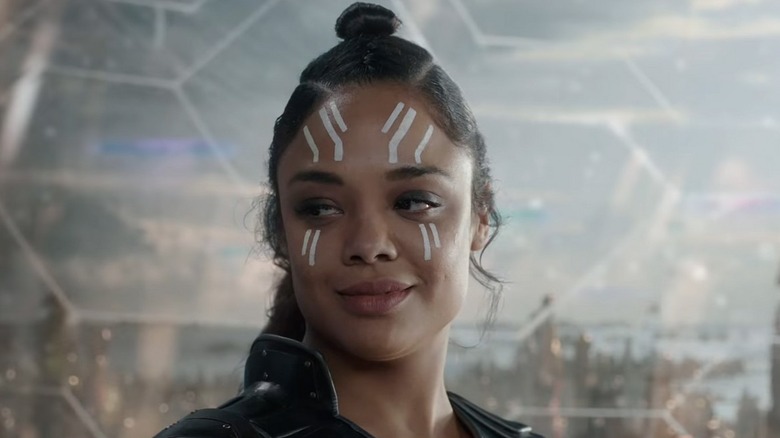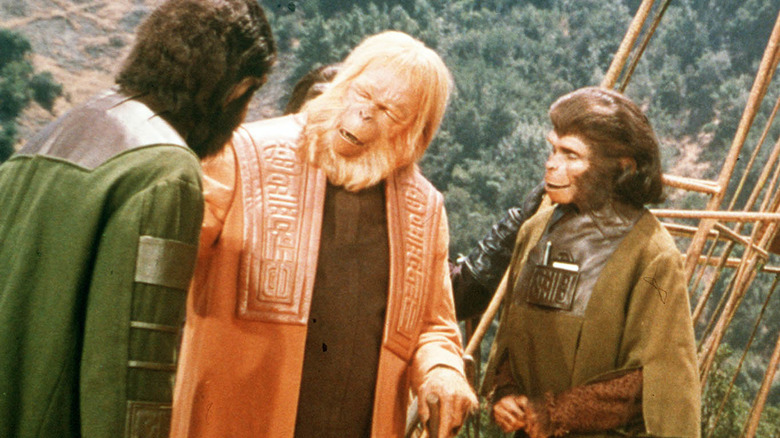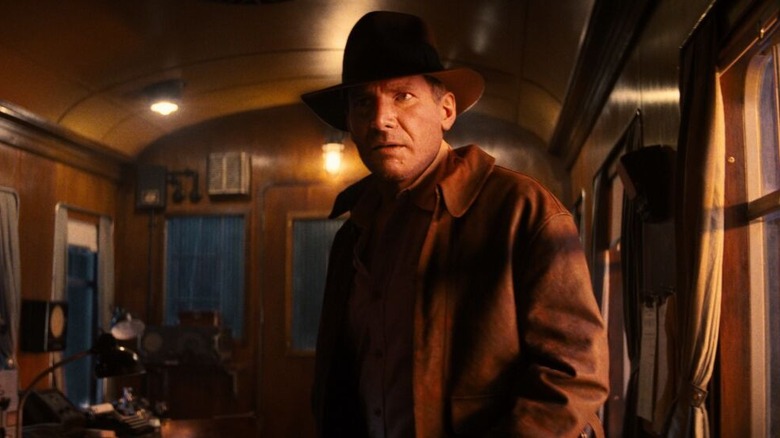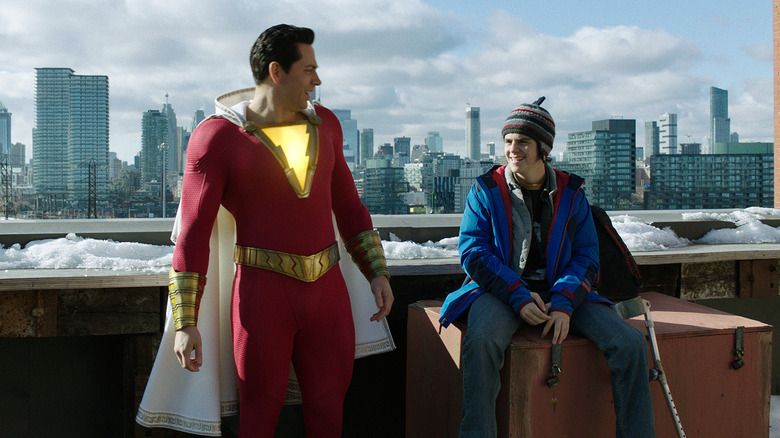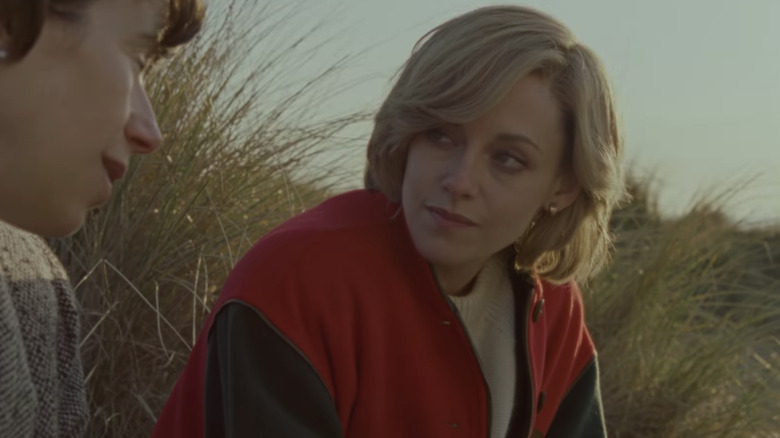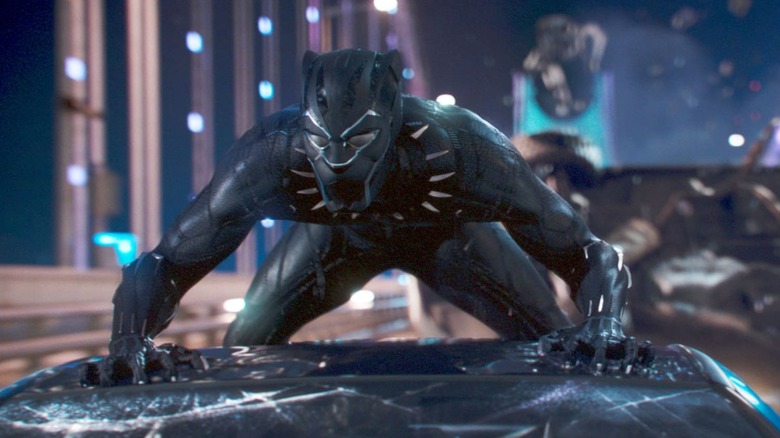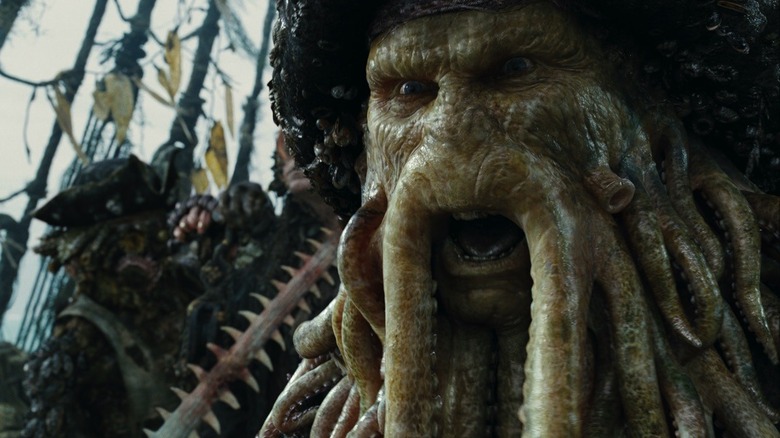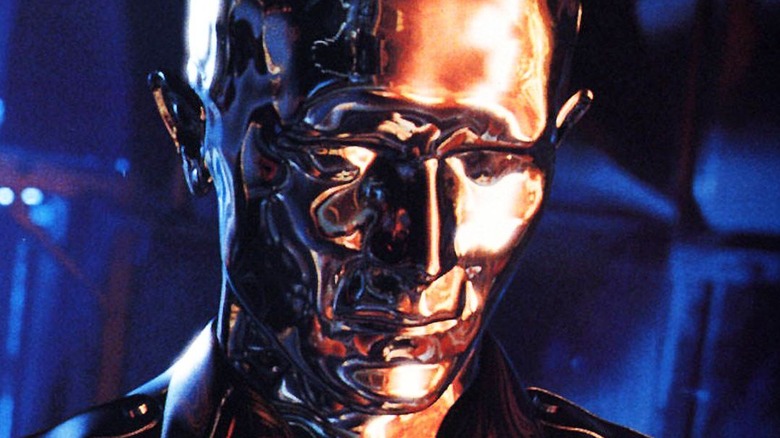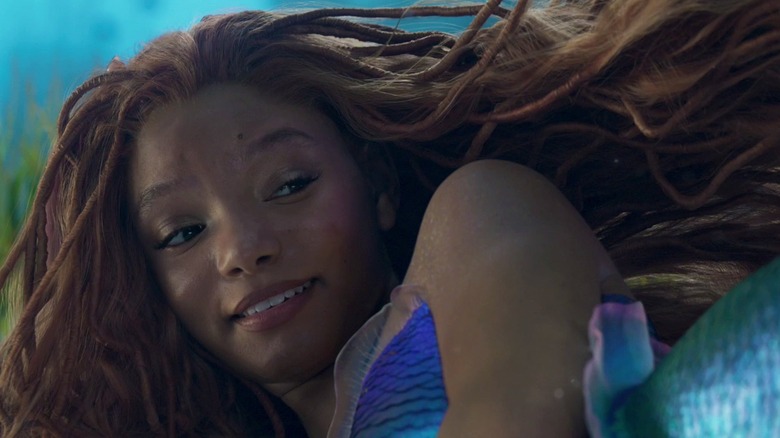Movie Character Transformations That Came With A Hefty Price Tag
There are many reasons why it's so expensive to make movies. The first thing most people think of are the stars' salaries, with a single A-lister sometimes taking home $20 million or more — add one or two additional big names to the mix, and actor payroll alone really drives up a film's budget. This doesn't even get into the literal hundreds of other people that are often involved with film production both in front of and behind the camera.
With some movies, there are very specific things that end up having a hefty price tag attached. For a lot of films, that typically comes by way of an epic climax — some building needing to be blown up, a giant monster attacking the city, or some other such money shot that is worth the spend because it's probably what got people to pay for a ticket in the first place. But there are times when a character or characters in a movie go through some sort of transformation — or the actor had to go through a major change to become the character in the first place — that ends up adding a significant amount to a movie's overall budget, sometimes even more so than those big, bombastic set pieces.
RoboCop had six different suits
Few films have done the "parodying a genre while also being an excellent example of said genre" thing as well as 1987's "RoboCop." Almost any movie that has tried to do that since has certainly looked to "RoboCop" as an example of how to do it right. In fact, "RoboCop" was so good at it that people have been able to enjoy it as both a satire of '80s action films and the perfect '80s action movie in equal measure, with neither approach being the wrong one.
The same can be said for the movie's cybernetic lead, portrayed by actor Peter Weller, who seemed to understand the duality of both the movie and its protagonist. He does such a great job that you'd never know how miserable he was filming the movie, as it was difficult to move in the cumbersome costume, see through its visor, or grab things with its hands. He immediately clashed with director Paul Verhoeven over these and other frustrations, and was fired early into filming, but the costume had been designed for Weller's height and body.
Considering that six RoboCop costumes were already made for the film at a total cost of $1 million, Verhoeven had no choice but to make up with Weller. Spending another million dollars on six new suits to transform a completely different actor into RoboCop would have added significant time and expense to what was otherwise a rather modestly-budgeted production.
Nicolas Cage wore 3D-printed teeth in Renfield
After doing a spate of forgettable direct-to-video films in the second half of the 2010s, Nicolas Cage seems to have successfully resurrected his career so far this decade. Among the movies that have repaired his reputation are "Renfield," the 2023 horror comedy in which Cage starred as a version of Dracula trying to survive the modern world with the help of his put-upon titular assistant (Nicholas Hoult).
Plenty of costume and makeup work went into turning Cage into one of the most iconic characters in history, from opulent fur coats and top hats to giving his skin the appearance of being blue and peeling. But the greatest expense came from Cage's teeth, with the usual approach of making only his canines vampire-sharp discarded in favor of giving him an entire mouthful of pointy fangs. This was accomplished by scanning Cage's real teeth and then having 3D-printed dentures made out of acrylic resin for the actor to wear.
Celebrated film and television makeup artist Christien Tinsley confirmed to Variety that dozens of models were created, both for practice and for actual use in the film. Given that the current going rate for 3D-printed dentures of regular human teeth is between $300 and $500 per set, that's several thousand dollars that were spent on Dracula's mouth alone — and that doesn't even include the rest of his makeup or costumes.
Alicia Vikander brought a robot to life in Ex Machina
One of the best sci-fi movies of the last 10 years — if not all time — is "Ex Machina," about a programmer (Domhnall Gleason) who is tasked with seeing if an advanced robot is capable of true human consciousness and connection. The robot has the form of a human woman and is named Ava, brilliantly played by Oscar-winning actor Alicia Vikander. The only parts of Ava that are fully human in appearance are "her" face and hands, with the rest consisting of circuitry, metal, and other synthetic material.
Ava isn't just Vikander in a robot outfit, however. Digital effects were needed to erase portions of Vikander's body, as parts of Ava are transparent and others consist only of wires. Although she was essentially a computer-generated character when all was said and done, Vikander filmed her scenes in person, with the rest done in post-production. In total, about 800 shots of Ava and various other robots and tech had to be digitally edited or enhanced in some way, with $5 million of the movie's budget reportedly devoted to that alone. It wasn't all spent on just Ava, but a large amount of it certainly was.
The effect is as convincing as it is stunning, winning the movie an extremely well-earned Oscar for visual effects despite tough competition from "Star Wars: The Force Awakens," "The Revenant," "Mad Max: Fury Road," and "The Martian."
Tessa Thompson needed a five-figure wig just for Thor: Ragnarok reshoots
Things can get tricky when an actor is working on two movies at once, especially when those two movies have vastly different requirements for the actor's look. One of the most infamous — and inadvertently hilarious — examples of this was when Henry Cavill's mustache had to be digitally removed while filming reshoots for "Justice League" because he needed that mustache for "Mission: Impossible — Fallout," which he was also working on at the time. The mustache removal work ended up being part of the reason that "Justice League" reshoots came in at a whopping $25 million.
Reshoots on another comic book movie would also end up adding a sizable expense to that movie's budget, but at least this one wasn't the result of petty squabbling between two studios. After shooting initially wrapped on "Thor: Ragnarok," Valkyrie actor Tessa Thompson had moved onto the film "Sorry to Bother You," for which her hair had been cut, bleached, and dyed. But Disney needed Thompson back for reshoots on the "Thor" sequel, so she had to wear a wig to match her hair in the scenes she had previously filmed. It had to look perfect so that the audience couldn't tell which scenes were original and which were from the reshoots, which required a $10,000 wig to maintain that continuity.
The makeup for Planet of the Apes (1968) was groundbreaking
The most recent "Planet of the Apes" films — the run that started with 2011's "Rise of the Planet of the Apes" — set new benchmarks for CG characters in live-action films. But the original movie, released in 1968, didn't have the benefit of computers or digital effects of any kind. So the movie's cast had to be turned into evolved, intelligent simians entirely through the magic of good old-fashioned Hollywood makeup and prosthetic work.
It was an extremely ambitious project for the time, especially given that over 200 actors and extras were going to need to have their own individual ape masks created for them. Makeup tests started as soon as the rights to the book the movie is based upon were acquired, which was back in 1965. Producer Arthur P. Jacobs claimed that the cost of not only the material for the makeup and prosthetics but the manpower required to apply and remove it all ended up totaling $1.5 million, which was almost a third of the entire budget for the film. Not only that, but putting on and taking off the makeup accounted for over half of the movie's total production time.
It took 100 people three years to de-age Harrison Ford for Indiana Jones 5
De-aging effects have come a long way in recent years, especially now that computers are involved. But to do it well, and over a prolonged period of screen time, requires a lot of time and money. Take for instance Martin Scorsese's 2019 crime epic "The Irishman," which saw its three leads — Robert De Niro, Joe Pesci, and Al Pacino — needing to play characters that were at times 40 years younger than the actors. This was accomplished via a long, expensive process which was said to be a key factor behind the movie's supposed $225 million budget, over $60 million higher than was originally intended.
Given that "The Irishman" earned 10 Academy Award nominations – not to mention being a huge hit for Netflix — it sent the message that there was a certain legitimacy to de-aging actors in tentpole movies. So Disney felt emboldened to spend a ton of cash on making Harrison Ford look like his fortysomething self for the entire 25-minute opening sequence of 2023's "Indiana Jones and the Dial of Destiny." While some have speculated that the cost of doing so came in at a cool $100 million, that figure has not been confirmed. What is certain is that a team of 100+ people worked on it for three full years, so it's very likely that the cost landed somewhere in the high eight-figure range, if not more.
Zachary Levi's Shazam costumes cost more than his salary
Back when the DC Extended Universe was still a viable thing, "Shazam" was one of the few lighter entries in the otherwise dark and gritty franchise. It tells the story of a 14-year-old boy named Billy Batson (Asher Angel) who meets a wizard that grants him the ability to transform into the superpowered hero Shazam simply by speaking the hero's name. When in the Shazam form, Billy takes on the physical appearance of an adult man, played by Zachary Levi.
Levi didn't have to buff up all that much to play Shazam — the muscles were built directly into the red, Superman-esque suit that he wears. Between that and the fact that the logo on his chest lights up, the suit was an impressive piece of tech that, surprisingly, wasn't just built in a computer as is often the approach to such things. All that tech came in at $1 million — which is even wilder when you learn that 10 suits were made for the film.
That $10 million spent on the Shazam costume alone was more than Levi's salary for the movie — though the amount he got paid for the first installment hasn't been revealed, he allegedly only made $2.5 million on the sequel, and typically salaries go up as a series go on. So it's quite possible that the "Shazam" costume budget for the first movie was more than Levi made for both films combined.
Two pricey wigs turned Stewart into Spencer
Some movie transformations are a bit more subtle than turning actors into apes, robots, or superheroes — but that doesn't mean they didn't still come with a huge bill. Take for instance "Spencer," the 2021 biopic where Kristen Stewart plays Princess Diana at a time of personal struggle for the tragic royal. But this isn't one of those cases where an actor had to endure layers upon layers of makeup and/or latex so that their face could match the person they are playing. Rather, this is another example of extremely costly wig work.
Stewart's physical resemblance to a 30-year-old Diana was close enough for the most part that she was able to convincingly play the role, helped along by her stellar performance. But rather than try to grow out Diana's blonde locks or style Stewart's hair the way Diana did, makeup designer Wakana Yoshihara decided to go the wig route. It wasn't a matter of going into the prop closet and picking one out, however — Yoshihara and wig maker Samuel James spent six whole weeks crafting from scratch and testing the two wigs that Stewart ended up wearing in the movie. Yoshihara said that the wigs came in at about $6,000 each, with one for scenes where Diana is performing royal duties and another for when she's being casual at home.
The practical Black Panther suits were ridiculously expensive
It's no big secret that a lot of the times you are watching a fully masked and costumed character in a big budget superhero movie — particularly during action scenes — you are seeing an entirely digital creation. But there are still plenty of moments throughout the Marvel Cinematic Universe that there is indeed a real person on set simply wearing a costume, and those costumes definitely don't come cheap.
For many scenes in "Black Panther," it was Chadwick Boseman or a stunt person right there on the set in the superhero's "habits," as his costume was referred to. It's definitely one of the more elaborate and technologically-advanced costumes in the entire MCU, at least outside of anything that Tony Stark has built.
By the time "Black Panther" was being made, Disney was long past caring very much about budgets for MCU films and was spending whatever was necessary to achieve Marvel Studios' creative vision — which led to six different Black Panther habits being created at a cost of $300,000 each. That's close to $2 million just for the physical Black Panther outfits. Costume designer Ruth Carter said that, for this type of movie, there should have been a lot more costumes made due to all the wear and tear, but they had to make do with less because of how expensive they were to make.
Pirates of the Caribbean's monster crew cost more than some entire movies
As mentioned in the introduction to this feature, a lot of movies have that one big effects-driven money shot that is used to not only get audiences cheering but is teased in trailers to get them to show up in the first place. "Pirates of the Caribbean: Dead Man's Chest," the first of what would be multiple sequels in the seafaring film franchise, definitely had such a moment. And this moment alone is said to have added an eye-watering $70 million to the movie's budget.
The scene in question comes when Davy Jones (Bill Nighy) and the rest of the crew of the doomed ship known as the Flying Dutchman reveal that they aren't actually the humans they appear to be, but are instead hideous sea monsters. The scene where they all transform in front of our eyes is certainly impressive, and is one of the most memorable moments of the entire franchise.
It goes without saying that it required a lot of time and effort to pull off, but the fact that it also required $70 million is shocking. Then again, the movie went on to gross over $1 billion worldwide — at a time when that was still fairly rare and wasn't being done by two or three movies every single year — so it was apparently $70 million well spent.
James Cameron's Terminator 2 broke new ground for morphing effects
Filmmaker James Cameron has spent most of his career pioneering new special effects technologies specifically for whatever movie he is working on at the time, and was doing so long before "Avatar" or even "Titanic." Though he had already toyed with liquid morphing effects for his lesser-known classic "The Abyss" in 1989, it was with 1991's "Terminator 2: Judgment Day" that he really took that to the next level.
Scenes of Robert Patrick's T-1000 morphing into a liquid metal form were heavily featured in the trailers and commercials for "T2," and for good reason — it was mind-blowing at the time, and much of it still holds up surprisingly well 30+ years later. "T2" was a movie that paid a lot for a little in several instances, such as star Arnold Schwarzenegger getting paid $15 million for a movie that only has him speaking 700 words of dialogue — which comes to a little over $21,000 per word.
As for the T-1000, the amount of screen time the character actually spends with some or all of his body being in liquid metal form is fairly little in the grand scheme of things, but those shots alone still added $5 million to the movie's effects budget — some done with computers and others created through models and prosthetics.
Halle Bailey's hair in The Little Mermaid cost $150K
Sometimes, a wig isn't an option for various reasons — such as a character needing to spend a large amount of time underwater. This was the case with the 2023 live-action adaptation of "The Little Mermaid," which saw actor Halle Bailey step into the role of aquatic Disney princess Ariel. Given that Bailey was going to be submerged under water for long stretches and also just have wet hair for much of the time when she wasn't, a traditional wig wasn't going to cut it to give the actor Ariel's long red locks.
Hair and makeup artist Camille Friend, an Oscar nominee for her work on the movie "Black Panther: Wakanda Forever," was called upon to do for Bailey what she had done for Lupita Nyong'o in that film. But between the aforementioned water issues and Bailey wanting to keep her natural hair for the role, it was clear that Friend had her work cut out for her. A simple dye job wasn't going to do the trick, either. So Friend's solution was to take red hair extensions and wrap them around Bailey's existing hair, giving it the red tint it needed but still having it be Bailey's natural hair. It was a process that was both time-consuming and extremely costly, with Friend estimating that about $150,000 was spent on the materials and labor just for Ariel's hair.
